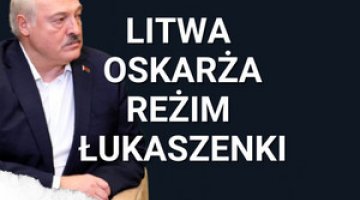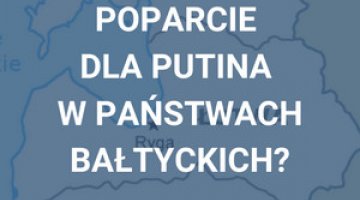The first round of parliamentary elections in Lithuania
The first round of parliamentary elections in Lithuania took place on 14 October. 52.82% of the electorate voted, which determined just over half of the seats in the new parliament (70 MPs from party lists and 3 from single-mandate constituencies). Only the results of the second round of voting, in single-mandate constituencies on October 28, will decide what the balance of power in the new Lithuanian parliament will be.The first round of voting was accompanied by a referendum, in which 62.71% of Lithuanians opposed the construction of a new nuclear power plant in the town of Visaginas (see Appendix 2). The results of the first round confirmed the decline in voters’ favour for the ruling right-wing. Although it was not a disaster for them (the two ruling parties came third and fourth, and the Prime Minister’s party may obtain the highest number of seats in the second round, and even for the whole elections), the opposition groups – above all, the Labour Party and the Social Democrats – received many more votes than they did four years ago.
The leader from the first round is the populist Labour Party, but they are likely to lose this position after the next round of voting. Although it has taken action to form an alliance with two opposition groups, the Social Democratic Party and the Order and Justice party, this does not prejudge the shape of the future coalition. Depending on the outcome of the second round, the Labour Party could enter some kind of right-wing alliance. Meanwhile, the Polish minority group AWPL achieved its main aim; for the first time it crossed the five-percent electoral threshold, and has a chance to create its own bloc in parliament.
Results from the first round
The Lithuanian parliament has 141 deputies, 70 of them from party lists by proportional representation (with a five-percent electoral threshold). The remaining 71 members are elected in single-mandate constituencies, but the winner must obtain 50% of the votes. After two weeks, a second round of elections takes place only in those single-mandate constituencies where there was no winner in the first round. The two candidates with the highest support from the previous round stand in these contests.
The results of the first round of the elections (see Appendix 1) established only 73 members, although the trends seen in the pre-election polls were confirmed. The Lithuanian public withdrew its high support of four years ago for the right-wing government of Andrius Kubilius, who confronted the economic crisis and the need to increase fiscal discipline by reducing the state’s social spending. His party, Homeland Union/Christian Democrats, was an uneasy mixture of several factions, ranging from liberals to nationalists, which made it difficult for him to carry out his plans. The government’s overly ambitious energy policy was also a factor, as the general public were afraid of how much it could cost. However, the party’s third placing in the first round, as well as the fourth place for their Movement of Liberals coalition partners, shows that despite the voters’ dissatisfaction with the government, the right wing still has a loyal electorate. It was also clearly supported by the popular President Dalia Grybauskaitė, who is interested in continuing the Kubilius government’s energy policy.
The Lithuanian public were swayed by populist slogans, as evidenced by the growing popularity of the Labour Party. In its election programme, this group made unrealistic promises of social support for all voter groups, which encouraged those Lithuanians who were tired of the previous austerity policies. The only opposition group presenting a definite programme, albeit based on criticising the actions of the government, is the Social Democrats.
The AWPL, mainly representing the Polish minority, crossed the five-percent electoral threshold for the first time. They owed their victory to high voter turnout in areas inhabited by Poles, as well as to their expanded electoral alliance, which took in not only representatives of the Russian minority, but also for the first time included the nationwide but currently insignificant People's Party, founded by the former Prime Minister Kazimira Prunskienė (although no candidate from her group received a mandate on the AWPL’s list). In the first round, the AWPL won 5 seats on the party list and one in a single-mandate region. In three single-mandate constituencies, its candidates are ahead going into the second round, and in a further three they are currently in second position. One more mandate would give them the opportunity to establish their own parliamentary bloc (which must have at least 7 members). The Polish group would then count as a potential partner in coalition-building. However, there is no chance of any significant improvement in the situation of the Polish minority in the short term. The Lithuanian groups have nothing to offer the Poles; only the Social Democrats’ programme contains items targeted at the minorities. They may possibly count on the return of the debate on surnames, as well as on the law on national minorities, which does not satisfy the Polish minority.
Possible post-election political arrangements
The next round of voting will reshuffle the results list. The Labour Party will probably lose its lead. The best chances of improving their standing, primarily as a result of their strong local support teams in the regions, are held by groups such as the Social Democrats and the Prime Minister’s Homeland Union/Christian Democrats. The latter may even extend its leading position; candidates of the party came first in up to 23 single-mandate constituencies. In second place are the Social Democrats with 17 candidates; the Labour Party has only 12 (see Appendix 1).
Among the groups which won the largest number of seats in the first round, the Labour Party has the best hope of forming a coalition. Depending on the second round results, and the offers that other groups will make it (Labour is interested in the economic ministries), it may enter into an alliance with the Social Democrats and Order & Justice, or with the right-wing (Homeland Union/Christian Democrats and the Liberal Movement). Considering the chances of each party’s candidates before the second round, a coalition with the right-wing would ensure the future government up to 77 votes in parliament; the left-populist coalition would only have 74 seats. The Labour leader Viktor Uspaskich is prepared for both variants. He did not criticise the Prime Minister as strongly as the Social Democrats did, and even offered him his support – in contrast to others in the opposition – on the vote on the nuclear power plant project, which was a signal to the right of his readiness to cooperate. The right will have to ensure the continuation of the Kubilius government’s energy policy, which aims to increase the country’s energy independence, including the continuation of major projects (an LNG terminal; power interconnectors to Poland and Sweden; the construction of a nuclear power plant), albeit possibly with some modifications. The alliance with the Social Democrats and the Order & Justice party which was hastily arranged after the first round may prove to be unstable. An obstacle to this coalition’s stability will be the parties’ ambitious leaders (Uspaskich and the Social Democrats’ Algirdas Butkevičius), as well as their rivalry which conceals business interests. In 2004, Uspaskich was the economy minister in the government of the Social Democrat Algirdas Brazauskas; at that time the two politicians competed to represent the interests of Gazprom. Uspaskich was quickly forced to resign (he fled to Russia) in the face of fraudulent bookkeeping allegations from the Lithuanian prosecutor’s office. Until now the Lithuanian court has been unable to proceed with his case. He may be afraid of further attempts to tarnish his image, which would weaken the Labour Party’s position in any left-populist coalition. If the Social Democrats improve their results in the second round, this would also make it more difficult for Uspaskich to take over the ministries related to the economy.
Appendix 1
Results from the first round of voting
|
Party |
Leader and definition of group |
Percentage of votes obtained / Number of seats in the first round of proportional voting |
Number of members who won in single-mandate constituencies |
Number of members coming second in single-mandate constituencies |
|
Labour Party
|
Viktor Uspaskich: MEP. A Russian; amassed a fortune as an intermediary in gas supplies from Gazprom. The Kremlin supported him when he was accused of financial fraud in Lithuania. Closely linked to the Russian Orthodox Church. The party, centred around its charismatic leader, is extremely populist. Uspaskich favours hushing up any disputes with Russia, but he has not always favoured Moscow’s economic interests in recent times. |
19,84%
17+1 in single-mandate constituency |
12 |
24 |
|
Social Democratic Party |
Algirdas Butkevičius is the new leader of the left. Recently the party has been the strongest critic of the government’s actions, including its energy policy and its confrontation with Gazprom. During the election campaign, it opposed the construction of a new nuclear power plant in Lithuania. They are interested in calming the severe disputes with Russia and Gazprom. |
18,38%
15+1 in single-mandate constituency |
17 |
10 |
|
Homeland Union/Christian Democrats |
Andrius Kubilius, the current prime minister. A right-wing party, whose aim in government was to conduct an energy policy aimed at increasing the country’s energy independence and reducing Gazprom’s dominant position in the Lithuanian energy sector. This led to an escalation of tensions in relations with Russia. The government projects include unbundling in the gas sector, an LNG terminal, electric power grids and their synchronisation with Western Europe, and the construction of a new nuclear power plant. |
15,05%
13 |
23 |
12 |
|
Movement of Liberals |
Eligijus Masiulis: his group was part of the last ruling coalition, but had no particular ambition to influence the dominant Homeland Union/Christian Democrats. They are formed of politicians who count on specific benefits from being in power, namely contacts within Lithuanian business, including companies transporting gas to Lithuania. |
8,57%
7 |
4 |
2 |
|
The Way of Courage |
Neringa Venckienė, the sister of the late Drąsius Kedys, who was suspected of murdering people related to the sexual abuse of his young daughter. Venckienė was a judge; she spoke out against the Lithuanian jurisdiction and the ‘mafia’ which rules them; her party consists of people who are outraged that the state institutions do not want to, or were unable to prevent, the tragedy in her family. Her party’s political programme still has not been announced. |
7,98%
7 |
0 |
9 |
|
Order and Justice |
Officially led by Valentinas Mazuronis; but the de facto leader is Rolandas Paksas, who is an MEP, and is still fighting to clear the charges laid against him during the impeachment procedure. The party has its roots on the right, but presents a Euro-sceptic, populist programme, and is centred mainly around Paksas.
|
7,31%
6 |
5 |
3 |
|
Electoral Action for Poles in Lithuania (AWPL) |
Waldemar Tomaszewski, an MEP. This group primarily represents the Polish minority, but in the election it competed with one of the two parties representing the Russian minority, as well as the openly pro-Russian People's Party grouping of the former Prime Minister Kazimira Prunskienė (the current leader of this group is her son). |
5,83%
5 + 1 in single-mandate constituency |
3 |
3 |
Appendix 2
What about the nuclear plant project?
The referendum will not determine the fate of the project. However, its results can be used not only as an argument to stop the construction of a nuclear power plant in Visaginas, but also to bring about an adjustment of the project. It is currently the most advanced project of its kind in the region (compared to the planned power plants in the Kaliningrad region, Belarus and Poland). The right-wing government which promoted it was unable to convince the public that the project has a strong economic base, and that it would not have to be paid for out of the pockets of ordinary energy users.
The referendum result poses a problem for the right, which is still supported by the investor and supplier of the reactor, the Japanese company Hitachi, who have declared a desire to continue the project. The partners from Latvia and Estonia are waiting for the new coalition before declaring their positions. It was decided that the investors would take the final investment decision by the year 2015; by that time, the planning phase is to be completed. The questions that Prime Minister Kubilius is currently unable to give to potential investors and the Lithuanian public should also be answered by then.
The Labour Party leader’s statement after the referendum is important: it opens up the possibility of offering the public another referendum on the power plant in around 2015. In this way, the Labour Party becomes a partner for the right, giving them the opportunity to continue the project. It is also possible that the Social Democrats will change their position (in fact it was they who initiated the project in 2007). They actually campaigned against this project, positioning themselves in opposition to the right, albeit by using the argument that the project is fundamentally ‘underdeveloped’. The Social Democrats have to reckon with the fact that if they take power, the right wing will be in opposition; and Prime Minister Kubilius’s group promoting the project plant will use any means necessary to convince the public that, in the long term, the high cost of importing electricity and gas from Russia will burden the Lithuanian economy and energy users much more than a new nuclear power plant constructed with foreign partners would.





